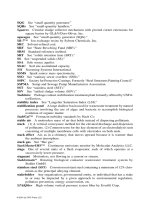Engineering Materials and Processes phần 10 pptx
Bạn đang xem bản rút gọn của tài liệu. Xem và tải ngay bản đầy đủ của tài liệu tại đây (140.83 KB, 7 trang )
Summary 117
Figure 7.4. RBS spectra (3.7 MeV He
+2
, 7° tilt) of the diffusion barriers before (broken line)
and after (solid line) testing at 620°C for 30 minutes in flowing atmosphere N
2
-5% H
2
ambient [8]
7.3 Electromigration Resistance
Electromigration (EM) resistance of Ag is the most critical interconnect reliability
concern that would determine its suitability for integrated circuit technology. EM is
the drift of metal ions as a result of either collision between the conductor electrons
and/or the metal ions or high electrostatic field force when current is passed
through a metal conductor. The direction of mass transport depends on the
direction of the net force. When high current densities pass through the metal line,
voids or hillocks are formed at a point of ion flux divergence (Figure 7.5). Voids
and hillocks deform and grow until electrical failure is completed [10].
118 Silver Metallization
Figure 7.5. Schematic to illustrate metal conductor failure due to electromigration [17]
Ho and Huntington [11], Patil and Huntington [12] reported that Ag migrates
toward the anode for the temperature range 670–877°C. Klotsman et al. [13] and
Breitling and Hummel [14] however, found that Ag ion transport is toward the
cathode, and is opposite to the direction of the electron wind. Studies conducted by
Hummel et al. showed that the dominating movement path is grain boundaries for
temperatures in the range of 225–280°C (activation energy of 0.95 eV) and surface
for the temperature range 160–225°C (activation energy of 0.3 eV) [15].
In this study the influence of an encapsulation process on the electromigration
resistance of Ag has been investigated. The sample configurations used consisted
of bare Ag patterns and encapsulated Ag patterns. Compared to bare Ag lines,
TiN(O) encapsulated Ag lines exhibited much better electromigration resistance in
terms of the time required for the formation of significant number of voids and
hillocks.
After the encapsulation process, the Ag surface is capped by a thin layer of
TiN(O). The mobility of Ag atoms at the TiN(O)/Ag interface is substantially
reduced. Therefore the electromigration resistance is improved significantly. By
examination of the surface of the encapsulated Ag lines tested for a long time,
almost no hillocks were observed. This implies that the surface diffusion has been
hindered substantially by the presence of the TiN(O) encapsulation. Comparison of
Tables 5.1 and 5.2 suggests that the encapsulation process improves the
electromigration resistance of Ag metallization by at least one order of magnitude
for the test structures and conditions used [16].
7.4 Future Trends
Ag metallization research has intensified significantly in recent years. Research
work has been conducted mainly in the US. Increasing numbers of companies have
already begun research and development (R&D) efforts in Ag-based metallization.
However in this highly competitive era the industrial research has been propriety.
Ag-based interconnects represents the future trend in the deep sub-micron regime.
Ag is an attractive material for interconnect-metallization in future integrated
circuits technologies due to its low bulk resistivity and high reliability against
Summary 119
electromigration. Ag can be deposited by plating (electroless and electrolytic),
sputtering (physical vapor deposition (PVD)), laser induced reflow and chemical
vapor deposition (CVD) cluster tools, chemical mechanical polishing (CMP)
polishers and low temperature etchers.
There are still many critical issues that remain to be resolved in the
development of Ag-based metallization. For instance, to meet the throughput
requirement in device manufacturing, there is a need to demonstrate a Ag
deposition technique with a high deposition rate (>250 nm/min) at low substrate
temperatures without simultaneously sacrificing low resistivity, good step coverage
and complete via fill. The adequate use of thin diffusion barriers in Ag-based
metallization will be critical for the 0.25 mm technology. Other materials science
issues in Ag-based metallization need to be address: (1) microstructural control
(e.g. grain size and texture); (2) contamination control (C, O and CI); (3) oxidation
and corrosion control; (4) prevention of Ag diffusion in metals and dielectric
materials; and (5) mechanical properties (e.g. stress migration, adhesion
improvement). In addition, the development of Ag-based on-chip interconnects
technology will also lead to new advancements in electronic packaging technology.
The implementation of Ag-based interconnects will represent the future trend in
the deep submicron regime.
7.5 References
[1] S. P. Murarka, R. J. Guttman, A. E. Kaloyeros, W. A. Lanford, Thin Solid
Films 236, 257(1993).
[2] M. E. C. Willemsen, A. E. T. Kuiper, A. H. Reader, R. Hokke,
J. C. Barbour, J. Vac. Sci. Technol. B 6, 53(1988).
[3] S. Q. Wang, I. Raaijmakers, B. J. Burrow, S. Suthar, K. B. Kim, J. Appl.
Phys. 68, 176(1990).
[4] T. L. Alford, D. Adams, T. Laursen, B. M. Ullrich, Appl. Phys. Lett. 68,
3251(1996).
[5] Y. L. Zou, T. L. Alford, D. Adams, T. Laursen, K. N. Tu, R. Morton,
S. S. Lau, MRS Proc. 427, 355(1996).
[6] J. Li, J. W. Mayer, E. G. Colgan, J. Appl. Phys. 70, 2820(1991).
[7] D. Adams, T. L. Alford, N. D. Theodore, S. W. Russell, R. L. Spreitzer,
J. W. Mayer, Thin Solid Films 262, 199(1995).
[8] Y. Wang, T. L. Alford, Appl. Phys. Lett. 74(1), 32(1999).
[9] D. Adams, Ph.D. dissertation, Arizona State University, 1996.
[10] M. Mahadevan, R. M. Bradley, J. M. Bebierre, Europhys. Lett. 45,
80(1999).
[11] P. S. Ho, H. B. Huntington, J. Phys. Chem. Solids 307, 1319(1966).
[12] H. R. Patil, H. B. Huntington, J. Phys. Chem. Solids 31, 463(1970).
[13] S. M. Klotsman, A. N. Timofeyev, I. S. Trakhtenberg, Phys. Metal
Metallogr. 14, 140(1962).
[14] H.M. Breitling, R. E. Hummel, J. Phys. Chem. Solids 33, 845(1972).
120 Silver Metallization
[15] R. E. Hummel, H. J. Geier, Thin Solid Films 25, 335(1975).
[16] Y. Zeng, L. H. Chen, Y. L. Zou, P. A. Nguyen, J. D. Hensen,
T. L. Alford, Mater. Lett. 45, 157(2000).
[17] D. Adams, T. L. Alford, Materials Science and Engineering R 40,
207(2003).
Index
Adhesion analysis, 54
tape test, 55
scratch test, 54
Ag on Pa-n, 51
compositional changes, 51
sheet resistance variation, 52
Ag on SiO
2
, 70
Ag(Ti) alloys, 20
Ag/barrier/silicide/silicon, 105
Ag/Ti-O-N/CoSi
2
/Si, 105
Ag/Ti-O-N/NiSi/Si, 105
Agglomeration, 2, 43–48, 69–73
Al(Cu), 75
Aluminum oxide, 59, 62, 84, 86, 93, 97
Aluminum properties, 5
bulk resistivity, 5
thin film resistivity, 5
diffusivity in Si, 5
self-diffusivity, 5
electromigration, 5
Young's modulus, 5
TCR, 5
mean free path of electron, 5
melting point, 5
thermal conductivity, 5
Ag sheet resistance, 36, 37
Amorphous-to-crystalline transition, 40
Annealing ambients, 57
argon ambient, 59
He-H ambient, 62
ammonia ambient, 63, 93
Annealing temperatures, 46
Auger depth profiles, 61
AES spectrum, 76
Bragg’s Law, 12
Bulk resistivity, 5
Cobalt silicide, 104
CoSi
2,
104
Composition of Ta-N, 31
Copper metallization, 4
Copper properties, 5
bulk resistivity, 5
thin film resistivity, 5
diffusivity in Si, 5
self-diffusivity, 5
electromigration, 5
Young's modulus, 5
TCR, 5
mean free path of electron, 5
melting point, 5
thermal conductivity, 5
Corrosion, 2, 22
encapsulated silver films, 22
H
2
S ambient, 29
Cu(Ti) alloys, 21
Copper (Cu), 5
Current density, 76
Dealloying kinetics, 18
Depth scale, 10
122 Index
Diffusion barriers, 15, 34
Diffusivity
in Si, 5
in SiO
2
, 1
Electromigration, 1, 5, 75, 76, 78–81
Electronegativity, 102
Encapsulation, 80, 81, 83
Energy resolution, 8
Failure mechanisms, 109
TiN(O)-encapsulated Ag lines, 80
electromigration resistance, 1, 75, 76
Formation of voids, 45
Four-point-probe, 49, 50, 52
van der Pauw, 70
Gold, 98, 101
H
2
S ambient, 24
Heat of formation, 93
Hillocks, 69, 75–81, 117, 118
Hole formation, 69
Hydrogen sulfide, 24
H
2
S ambient, 24, 25, 28, 29
Identification of phases, 39
Impurity scattering factor, 46
Interfacial energy barrier, 94
Ion resonances, 11
Joule heating, 78, 80
Kinematic factor, 8
Kinetics in Ag/Al bilayer systems, 83, 97
reaction kinetics, 83
outdiffusion of Al through Ag, 83
Kinetics of oxide, 89, 93
growth kinetics, 89
Law of Reflectivity, 12
Mass transport, 43
Melting point, 5
Nitridation, 20, 28
Nitrogen, 41
N
2
flow, 30, 34–40
interstitial nitrogen, 40
Onset temperature, 70–73
Outdiffusion of Al, 60, 62, 67
Oxide surface layer, 84, 89, 93, 95
Parylene, 48, 49
Pa-n, 48, 49
dielectric, 48, 49
reliability issues, 549
phase change, 50
Polyimides, 2, 548
Recoil energy, 8
Refractory metal nitrides, 15
Resistivity, 5, 17, 34, 39
Resonances, 11
RUMP, 17, 18
Rutherford backscattering spectrometry
(RBS), 8
Scattering cross section, 9
Scattering kinematics, 8
Self-diffusivity, 5
Self-encapsulation, 15
Silicide, 40
Silver, 1, 5
Ag, 1, 2, 5, 29, 79
Silver properties, 5
bulk resistivity, 5
thin film resistivity, 5
diffusivity in Si, 5
self-diffusivity, 5
electromigration, 5
Young's modulus, 5
TCR, 5
mean free path of electron, 5
Index 123
melting point, 5
thermal conductivity, 5
Silver-aluminum films, 46
Silver sulfide, 25
Stress, 67, 69
compressive stresses, 67, 69
thermal stresses, 67, 69
thermal expansion coefficients, 67
Surface energies, 67
Surface oxide layer, 102
Surface peak Al, 98
Tantalum nitride, 30
Ta-N films, 30, 39, 41
Ta-N diffusion barriers, 30, 34, 36
Ta-silicide, 40, 41
Test structures, 79
Thermal conductivity, 5
Thermal stability, 4, 43
Thermodynamic data, 93
Gibbs free energy, 93
enthalpy, 95
Thin film characterization, 7
Thin film resistivity, 5
TiN encapsulation, 24
TiN(O), 18, 117
Titanium nitride, 16, 113, 114
Titanium nitride self-encapsulation, 16
Transport of aluminum, 91
X-ray diffractometry, 12
XRD, 13, 30, 33, 37–41, 44, 46–50, 52









